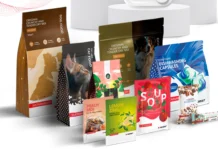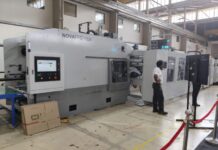During the ongoing Bobst Days 2021, Ludovico Frati, product manager at Bobst, and Daragh Whelan, OneECG process manager at Bobst, talked about short runs in flexible packaging. And how Bobst’s inline narrow web unit-to-unit flexo presses together with oneECG printing can help wide web convertors stay profitable in the face of customer demand for shorter run lengths.
Whelan said that the Bobst Master M6 flexo press delivers consistent results on unlimited substrates for convertors eyeing the short-run business. He said that the M6 could produce IML, shrink sleeves, and wrap-around labels. It can process standard materials such as BOPP, some LDPs, and the new generation MDOP materials in flexible packaging. The M6 can also do lamitubes, alufoils, and also some folding cartons. “This is a very versatile press and is equipped with the extended color gamut printing,” Whelan said.
Extended color gamut – OneECG
OneECG is Bobst’s extended color gamut (ECG) technology deployed across analog and digital printing processes in label, flexible packaging, folding carton, and corrugated board industries. ECG is a process to digitize color matching, thus making it stable, easy, repeatable, consistent, and independent of human interpretation.
ECG refers to a set of inks – 4 and beyond, but typically seven inks to achieve a color gamut larger than the traditional CMYK, enabling color repeatability irrespective of the operator’s skill. ECG makes sense because brand owners and consumers perceive color variations as lacking product quality, heavily affecting brand identity and customer loyalty. A brand’s signature colors should be consistent irrespective of the printing process, the substrate, and the country where the packaging is produced.
Benefits of the Bobst Master M6 oneECG press
During the presentation, Whelan compared the Bobst Master M6 oneECG press with the conventional flexo presses and shared some numbers. He said that the M6 requires one set up against two for conventional flexo, has seven plates compared to as many as 14, the number of ink mixes (Pantone) is zero compared to six in a traditional flexo press. The total make-ready material for M6 is 50 meters compared to 200 meters in a conventional press, and the first job make-ready time is 10 minutes versus sixty minutes in traditional flexo. The total make-ready time of the M6 is 10 minutes versus 90 minutes for a conventional narrow web flexo press.
“When we speak to the customers, they say that the biggest benefit of the oneECG M6 is that they can increase the meters [produced] and also if the format size is small, they can do many different SKUs across the web,” he said.
Whelan said that the drastically shorter make-ready time of M6 means the press is useful for short-run flexible packaging work. Frati summed up the presentation and said that the M6 is ideal for mid and short-run flexible packaging work, offers high uptime for greater profitability, and helps convertors broaden their offerings.











